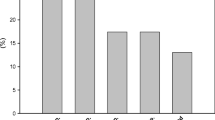Abstract
In this study, we evaluated the concentrations of culturable airborne bacteria (CABs) in the underground environment of 16 subway stations in Seoul, South Korea. The effects of environmental factors on CAB distributions and concentrations, including temperature, relative humidity, depth, year of construction, number of subway passengers, and ventilation, were investigated. Tryptone soy agar was used as the culture medium. Isolated bacteria were initially characterized according to cell morphology and Gram staining and then further characterized using the VITEK 2 XL microbial identification system. There were significant correlations between CAB concentrations and station temperature, depth, and construction year. Micrococcus and Staphylococcus species accounted for 66 % of the total number of CABs identified. CAB concentrations in stations with ventilation systems were significantly lower than those in stations without ventilation systems (p < 0.001). Thus, it is critical to develop techniques to improve indoor air quality in subway stations with no ventilation system.


Similar content being viewed by others
References
American Conference of Governmental Industrial Hygienists (ACGIH) (1999) In: Macher J, Ammann HA, Milton DK, Burge HA, Morey PR (eds) Bioaerosols: assessment and control. American Conference of Governmental Industrial Hygienist, Cincinnati
Awad AHA (2002) Environmental study in subway metro stations in Cairo, Egypt. J Occup Health 44:112–118
Bogomolova E, Kirtsideli I (2009) Airborne fungi in four stations of the St. Petersburg underground railway system. Int Biodeterior Biodegrad 63:156–160. doi:10.1016/j.ibiod.2008.05.008
Boudia N, Halley R, Kennedy G, Lambert J, Gareau L, Zayed J (2006) Manganese concentrations in the air of the Montreal (Canada) subway in relation to surface automobile traffic density. Sci Total Environ 366:143–147. doi:10.1016/j.scitotenv.2005.09.094
Cho JH, Hee Min K, Paik NW (2006) Temporal variation of airborne fungi concentrations and related factors in subway stations in Seoul, Korea. Int J Hyg Environ Health 209:249–255. doi:10.1016/j.ijheh.2005.10.001
Commission of the European Communities (CEC) (1993) Indoor Air Quality and Its impact on Man, Report No. 12. Biological Particles in Indoor Environment, Luxemburg
Dybwad M, Granum PE, Bruheim P, Blatny JM (2012) Characterization of airborne bacteria at an underground subway station. Appl Environ Microbiol 78:1917–1929. doi:10.1128/aem. 07212-11
Goyal R, Kumar P (2013) Indoor–outdoor concentrations of particulate matter in nine microenvironments of a mix-use commercial building in megacity Delhi. Air Qual Atmos Health 6:747–757. doi:10.1007/s11869-013-0212-0
Heseltine E, Rosen J (2009) WHO guidelines for indoor air quality: dampness and mould. WHO Regional Office for Europe, Copenhagen
Horii T, Tamai K, Mitsui M, Notake S, Yanagisawa H (2011) Blood stream infections caused by Acinetobacter ursingii in an obstetrics ward. Infect Genet Evol 11:52–56. doi:10.1016/j.meegid.2010.10.011
Hornung RW, Reed LD (1990) Estimation of average concentration in the presence of nondetectable values. Appl Occup Environ Hyg 5:46–51
Hwang SH, Yoon CS, Ryu KN, Paik SY, Cho JH (2010) Assessment of airborne environmental bacteria and related factors in 25 underground railway stations in Seoul, Korea. Atmos Environ 44:1658–1662. doi:10.1016/j.atmosenv.2010.01.047
Hwang SH, Park DU, Ha KC, Cho HW, Yoon CS (2011) Airborne bacteria concentrations and related factors at university laboratories, hospital diagnostic laboratories and a biowaste site. J Clin Pathol 64:261–264. doi:10.1136/jcp.2010.084764
Kim KY, Kim YS, Roh YM, Lee CM, Kim CN (2008) Spatial distribution of particulate matter (PM10 and PM2.5) in Seoul Metropolitan Subway stations. J Hazard Mater 154:440–443. doi:10.1016/j.jhazmat.2007.10.042
Kim KY, Kim YS, Kim D, Kim HT (2011) Exposure level and distribution characteristics of airborne bacteria and fungi in Seoul metropolitan subway stations. Ind Health 49:242–248
Lee SC, Guo H, Li WM, Chan LY (2002) Inter-comparison of air pollutant concentrations in different indoor environment in Hong Kong. Atmos Environ 36:1929–1940
Leung HY, Wilkins D, Li KT, Kong KF, Lee KH (2014) Indoor-air microbiome in an urban subway network: diversity and dynamics. Appl Environ Microbiol 80:6760–6770. doi:10.1128/aem. 02244-14
Mendell MJ, Lei-Gomez Q, Mirer AG, Seppanen O, Brunner G (2008) Risk factors in heating, ventilating, and air-conditioning systems for occupant symptoms in US office buildings: the US EPA BASE study. Indoor Air 18:301–316. doi:10.1111/j.1600-0668.2008.00531.x
Ministry of Environment of Korea (2014) Indoor Air quality management in public facilities Indoor Air Quality Management Act Amendment
NIOSH (National Institute of Occupational, Safety and Health) (1998) Sampling and characterization of bioaerosols. NIOSH Manual Anal Methods 4:82–112
Robertson CE, Baumgartner LK, Harris JK, Peterson KL, Stevenss MJ, Frank DN, Pace NR (2013) Culture-independent analysis of aerosol microbiology in a metropolitan subway system. Appl Environ Microbiol 79:3485–3493. doi:10.1128/aem. 00331-13
Salonen H, Lappalainen S, Lindroos O, Harju R, Reijula K (2007) Fungi and bacteria in mould-damaged and non-damaged office environments in a subarctic climate. Atmos Environ 41:6797–6807
Seino K, Takano T, Nakamura K, Watanabe M (2005) An evidential example of airborne bacteria in a crowded, underground public concourse in Tokyo. Atmos Environ 39:337–341. doi:10.1016/j.atmosenv.2004.09.030
Seoul Metro (2012) Assessment of indoor air quality in Seoul Metro environment
Seppanen O, Fisk WJ (2002) Association of ventilation system type with SBS symptoms in office workers. Indoor Air 12:98–112
Smith KR (2008) WHO air quality guideline: moving indoors. Air Qual Atmos Health 1:17–18. doi:10.1007/s11869-008-0010
Son YS, Lim BA, Park HJ, Kim JC (2013) Characteristics of volatile organic compounds (VOCs) emitted from building materials to improve indoor air quality: focused on natural VOCs. Air Qual Atmos Health 6:737–746. doi:10.1007/s11869-013-0207-x
Tsai FC, Macher JM (2005) Concentrations of airborne culturable bacteria in 100 large US office buildings from the BASE study. Indoor Air 15(9):71–81
Zhang Z, Yu S, Wang Y, Wang X, Feng J, Ye B (2007) Ambient air quality of subway trains in Shenzhen. Chin J Public Health Eng 6:343–344
Zhou F, Wang Y (2013) Characteristics of antibiotic resistance of airborne Staphylococcus isolated from metro stations. Int J Environ Res Public Health 10:2412–2426. doi:10.3390/ijerph10062412
Author information
Authors and Affiliations
Corresponding author
Rights and permissions
About this article
Cite this article
Hwang, S.H., Park, W.M., Ahn, J.K. et al. Relationship between culturable airborne bacteria concentrations and ventilation systems in underground subway stations in Seoul, South Korea. Air Qual Atmos Health 9, 173–178 (2016). https://doi.org/10.1007/s11869-015-0316-9
Received:
Accepted:
Published:
Issue Date:
DOI: https://doi.org/10.1007/s11869-015-0316-9




